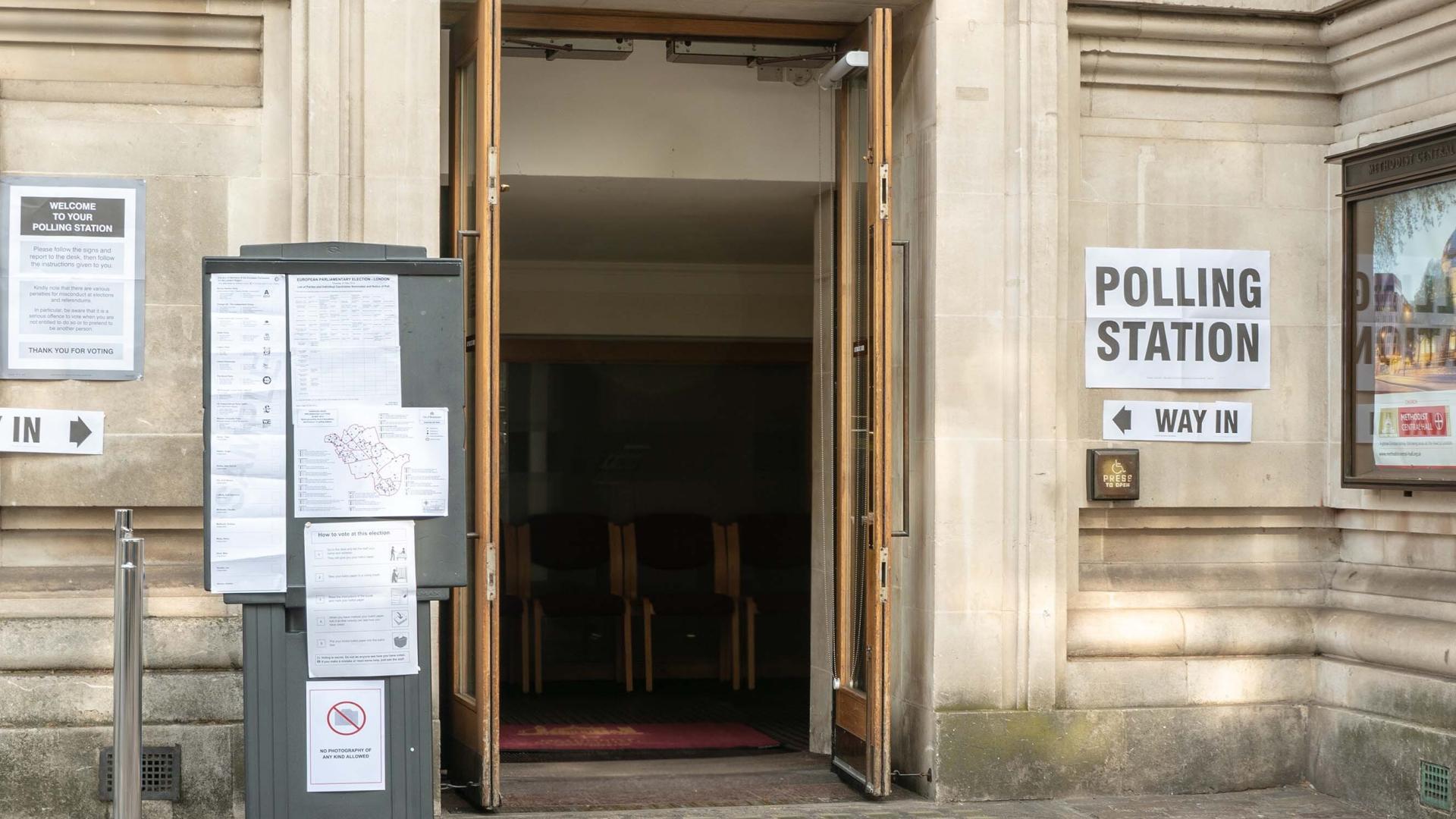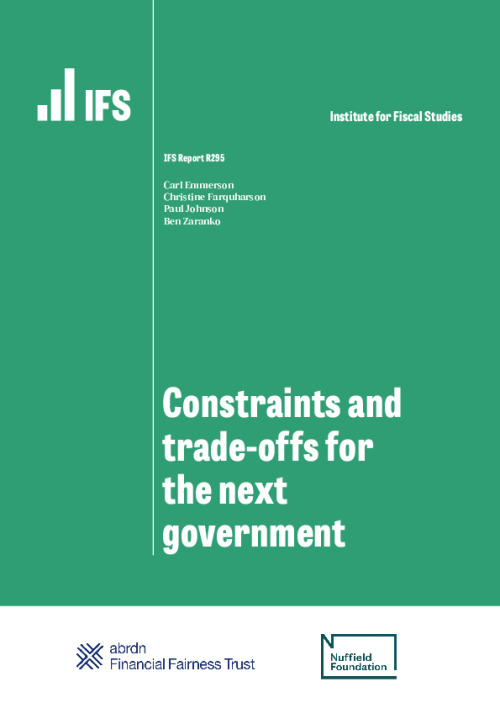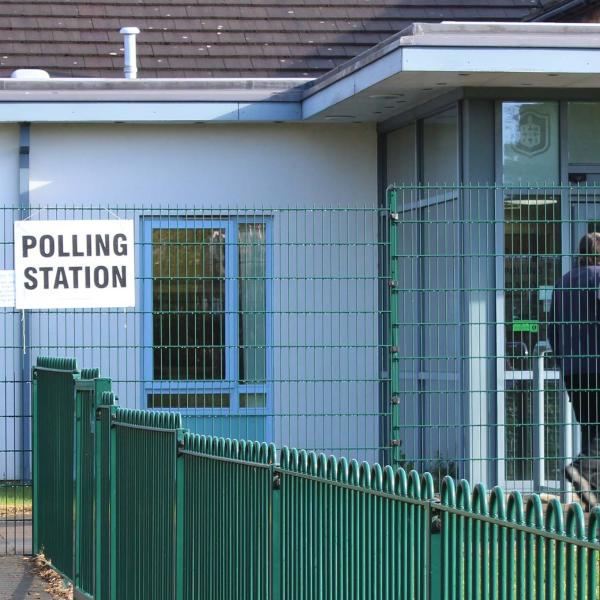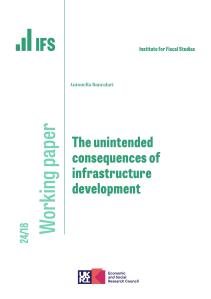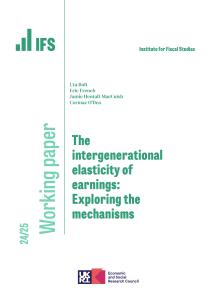Executive summary
The UK finds itself in an unfortunate economic and fiscal bind. Living standards have endured an unprecedentedly long stagnation. Taxes are at record levels for the UK (though remain low-to-middling by European standards). Public services are showing visible signs of strain and are, in many cases, performing less well than they were in 2010. Further tax rises and further cuts for most public services are built into current plans. But on official forecasts, this is only just enough to stabilise government debt as a fraction of national income.
This will be a thorny inheritance for whoever is in office after this year’s general election. Both Labour and the Conservatives have promised to reduce debt as a fraction of national income. Yet a combination of high debt interest payments and low growth is forecast to make this much more difficult to achieve than in the recent past. In fact, on one measure, it will be more difficult to reduce the debt-to-GDP ratio over the next parliament than in any other parliament since the 1950s.
Everything is harder when the economy is growing slowly and the public finances are more constrained. All manner of policy problems will be more difficult to tackle, and all manner of trade-offs will be more acute. Examples include:
- Current government spending plans include a large cut to public investment over the rest of the decade. Even with Labour’s plans for an extra £20 billion of ‘green investment’, total public investment would still be forecast to fall. Higher investment might boost our future prosperity but, without scope to increase debt, would mean less consumption now – a difficult ask when living standards have been squeezed for so long.
- When the public finances are so constrained, tax cuts today add to the risk of tax rises or spending cuts tomorrow. It might be easy to announce immediate tax cuts, without any hint of what it is the state currently does that it will stop doing, or what taxes will rise in future, but this trade-off cannot be wished away.
- A tight funding environment will make it more difficult to rebalance public service spending. Under reasonable assumptions for day-to-day spending on the NHS, schools, defence, international aid and childcare, the government’s plans imply a £20 billion cut to day-to-day spending on other public services. And if no extra money is available, you cannot increase spending on preventative services, for example, without making cuts elsewhere. Desperately needed rationalisation of local government finance is much harder. It will also be harder to pursue desperately needed tax reform without creating losers.
- Net immigration is at record levels, and both major parties have pledged to bring it down. But a substantial reduction in the number of foreign care workers would pose enormous challenges for the adult social care sector. Similarly, the university sector is increasingly dependent on income from foreign students. The parties seem less keen to talk about the additional funding for social care, or the higher tuition fees for domestic students, that would almost certainly be required if immigration numbers were sharply reduced (unless provision in these areas is to be scaled back).
- The UK has made good progress towards its net zero target and much better progress than many other high-income countries. But we are running out of low-hanging fruit. The next stage of the transition, especially reducing emissions from the heating of residential and commercial buildings, will mean pursuing policies that impose explicit – and potentially highly salient – short-term costs on households and businesses. This may well be a price worth paying, but it will not be pain free.
- The amount spent on disability benefits is large and rising rapidly as the number of claimants continues to grow. For politicians looking to cut taxes or increase spending elsewhere, these (and working-age benefits more broadly) might look like a tempting place to go in search of savings. But the generosity of many working-age benefits has already been cut, and to do more could cause more serious hardship. Previous efforts to rein in spending have also struggled to achieve their objectives.
- In many policy areas, the gains from reform or action are spread across a large number of people, but the losses are concentrated among a much smaller – and more vocal – group. This is true of the transition to net zero (e.g. where erecting pylons to transport electricity to where it is needed brings national gains but upsets local communities), housing policy (for similar reasons), tax reform (which inevitably creates losers as well as winners), and much else besides. Financial compensation for the losers from any reform can help ‘grease the wheels’, but comes at a fiscal cost at a time when funding is scarce.
These challenges – unlike a conflict, pandemic or financial crisis – are entirely predictable. None can be meaningfully confronted by a government that wilfully ignores reality and the need to choose between difficult competing options. As tempting as it may be to engage in ‘cakeism’ – to seek to have the government’s fiscal cake and eat it – any party serious about governing after the election should resist the urge. The electorate surely deserves better than that.
1. Introduction
Life is about trade-offs. Governing is no different. Governments always need to weigh priorities against one another, consider the benefits and costs of different proposals (and those of sticking with the status quo), choose who to make better and worse off, and choose how much weight to put on different competing objectives. But in a heavily constrained fiscal environment, with limited funds available to soften some of the harsher edges of government reforms, these trade-offs can become all the more acute.
This is the situation in which the next government is likely to find itself. Taxes are at a record level for the UK (though are still low-to-middling by European standards), having risen by more during this parliament than during any other in the post-war period (Emmerson, Johnson and Zaranko, 2023). Yet following the austerity of the 2010s and the disruption of a pandemic, many public services feel broken. The Institute for Government’s ‘Performance Tracker’ examined nine separate public services in 2023 and concluded that all, with the exception of schools, were judged to be performing worse than they were in 2010 (Davies et al., 2023). This is an unfortunate combination, and a difficult starting point for any government.
The two main UK-wide political parties have a commitment to have the debt-to-GDP ratio (i.e. national debt as a share of national income) on a falling path. The challenge is that with higher levels of spending on debt interest and forecasts suggesting that economic growth will continue to be weak, getting debt falling will be much more difficult than in the recent past – and arguably more difficult than at any point in the post-war period. As a result, there will be limited scope to cut taxes or increase spending by a meaningful amount while staying within that constraint.
This will prove to be a difficult fiscal inheritance for whoever is Chancellor after the general election. Fiscal constraints will make all manner of policy problems more difficult to tackle and will make all manner of trade-offs more acute. But these trade-offs cannot be simply wished away. As tempting as it may be to engage in ‘cakeism’ – to seek to have the government’s fiscal cake and eat it – any party serious about governing after the election should resist the urge. To have any hope of improving our lot, the next government will need a strong mandate and laser-eyed focus. Levelling with British households and businesses about the state of the world, confronting the challenges we face and providing a sense of policy direction would be a step in the right direction. To shy away from the challenge now only adds to the risk that we fail to confront these challenges in the next parliament.
2. The fiscal inheritance for the next parliament
The fiscal bind awaiting whoever is Chancellor after the election
Three big negative shocks to the public finances in the period since 2008 (the global financial crisis, the COVID-19 pandemic and the more recent cost-of-living crisis) have pushed public sector net debt to above 90% of national income – a level not seen since the early 1960s. High levels of debt can bring risks – pushing up the cost of servicing that debt and reducing the government’s available fiscal space to respond to adverse shocks in future.
This suggests that there are good reasons to generally think that debt should be falling in the ‘good times’, and not on an ever-rising path. The current government is committed to having debt as a share of national income (the debt-to-GDP ratio) on track to fall in five years’ time. This is not the government’s only fiscal target, but in the current climate it is the one that binds in practice. Labour, similarly, is committed to having debt on a falling path.
There are three broad options to achieve falling debt as a share of national income. First, the government can grow it away (raising national income, and so reducing the ratio). Second, the government can inflate it away (which also raises national income in cash terms, while leaving the cash-terms value of debt unchanged). Third, the government can run sufficiently tight fiscal policy for debt to fall as a share of national income under prevailing nominal growth (g) and interest rates (r). These rates (often summarised as r minus g), combined with the overall level of public sector debt, dictate (to a first approximation) the primary deficit or surplus (i.e. the deficit or surplus after stripping out spending on debt interest) that is consistent with debt being stable as a fraction of national income. All else equal, higher interest rates (higher r) or lower growth (lower g) mean tighter fiscal policy is required to stop debt rising.
The key point is that official forecasts suggest that a weak outlook for growth (low g) combined with much higher interest rates than we became accustomed to over the 2010s (high r) will make it more difficult to get debt falling in the next parliament than at any point in the post-war period. The post-election Chancellor’s economic and fiscal inheritance will be miserable.
This is summarised in Figure 1. The horizontal axis shows the average nominal GDP growth rate over each parliament (which captures both the rate of economy-wide inflation and the rate of real growth). The vertical axis shows the average level of spending on debt interest (which captures both the level of debt and the average rate of interest paid upon it) as a share of GDP. Governments would prefer to be in the bottom-right quadrant, with high (nominal) growth and low debt interest spending. But the OBR’s forecasts – which are, of course, uncertain and will be revised again and again over time – suggest that the next parliament will sit firmly in the upper-left quadrant, with lower-than-average nominal GDP growth (average 3.6% per year) and higher-than-average debt interest spending (average 3.7% of GDP).
These are not propitious circumstances in which to be aiming for a falling debt-to-GDP ratio. For comparison, over the first term of the last Labour government (defined here as 1996–97 to 2001–02), nominal growth averaged 4.5% per year (almost 1 percentage point higher than the 3.6% per year currently forecast for the next parliament) and debt interest spending averaged 2.6% of GDP (versus the latest official forecast of 3.7% for the next parliament). All parliaments with slower rates of growth than what is forecast for the next parliament had below-average debt interest spending; all parliaments with higher debt interest spending had above-average growth. For a Chancellor with a goal of reducing debt as a fraction of national income, things have arguably never been so bad.
We can reach a similar conclusion looking at the debt-stabilising primary balance (the deficit or surplus, excluding net debt interest spending, that is consistent with a stable debt-to-GDP ratio): this is at a higher level than at any point since 2010, and at a higher level than was seen for the vast majority of the post-war period (Office for Budget Responsibility, 2020 and 2023a). It can also be seen if we look at the headline figures for overall levels of tax and spending (Figure 2). Government revenues have increased steadily, from 36.8% of national income on the eve of the pandemic to an expected 41.2% of national income in 2024–25. This increase was fuelled by the current parliament being the biggest tax-raising parliament in modern times – tax receipts were 33.1% of national income in 2019–20 and are forecast to be almost 4% of national income higher, at 37.0%, in 2024–25. The level of government spending as a share of national income spiked during the pandemic and, while it now appears to be on a declining path, it is still forecast to run well above pre-pandemic levels throughout the next five years.
A big chunk of that increase is debt interest spending: almost 9% of total government revenues are set to go towards debt interest costs over the next parliament, under the OBR’s most recent forecasts, up from an average of 5.5% over the 2000s and 2010s. In fact, revenues are forecast to exceed non-debt-interest spending from 2024–25 onwards. By 2028–29, the government is set to be running a primary surplus of 2.2% of national income (i.e. to have revenues exceeding non-debt-interest spending by 2.2% of national income). The last time the UK government ran a primary surplus that big was 2000–01. The last time the UK government ran a primary surplus of any size was 2001–02. In other words, this is much tighter fiscal policy than we have become accustomed to – and that is only just enough to stabilise debt under the latest official forecasts. And even that forecast is predicated on non-debt-interest spending falling quite sharply as a share of national income in 2026–27, 2027–28 and 2028–29. But despite these planned reductions – which would require tight spending plans for many government departments – the forecasts still imply a higher level of non-debt-interest spending in 2028–29 than pre-pandemic (2019–20) and than pre-financial crisis (2007–08).
This will make a whole raft of unavoidable trade-offs more acute
Fiscal sustainability is not an end in itself, and promises to get the public finances in order might not quicken the pulse of would-be voters. But this is a constraint within which the government must operate. The Labour and Conservative parties seemingly have the same interpretation of fiscal sustainability: both are committed to having the debt-to-GDP ratio on a falling path. As a fiscal rule, this makes no distinction between borrowing for different purposes: borrowing to fund tax cuts or an increase in benefits is treated exactly the same as borrowing to fund additional investment in transport infrastructure. This is not to say that this is the only reasonable definition of fiscal sustainability, but both major parties do seem committed to operating within this particular constraint.
The problem is, staying within that constraint in a low-growth, high-interest-rate world will be much harder than it was in the past. This will inevitably make it more difficult for the government to make progress on things we do actually, inherently, care about as ends in themselves.
It will also make a whole range of unavoidable trade-offs more acute. In a tight fiscal environment, for governments to pursue their priorities will require painful choices to be made elsewhere. These cannot be wished away.
To make matters worse, whoever is in office after the election will face an electorate that has endured an unprecedentedly long squeeze on living standards. On one measure, average household disposable incomes are currently no higher than in 2015–16, only slightly up on their 2007–08 level, and £10,000 per household per year lower than they would have been had they grown since 2008 at their long-term rate (Figure 3). That makes for a difficult backdrop against which to ask households to accept the sharp end of difficult choices.
But as economists are fond of saying, there is no such thing as a free lunch. In Section 3, we go through the lunchtime menu and outline some of the key trade-offs that any party serious about governing ought to confront.
3. To govern is to make trade-offs
Tax cuts now imply tax rises or spending cuts further down the line
There is growing speculation that the government will announce tax cuts in the March 2024 Budget ahead of a general election later in the year. It may well prove possible for the Chancellor to announce tax cuts at the Budget without breaching his fiscal rules – for example, if the recent reduction in interest rate expectations feeds through into an improvement in the Office for Budget Responsibility’s assessment of the fiscal outlook. That does not necessarily mean that tax cuts at this moment in time are a good idea. Announcing immediate, definite and permanent tax cuts in response to highly uncertain changes in a volatile forecast, but accepting higher borrowing whenever things get worse, is not a recipe for fiscal sustainability (Emmerson et al., 2023).
Even if one believes that now is indeed the right moment for tax cuts, tax cuts today must add to the risk that either tax rises or spending cuts are required further down the line. Well-designed tax cuts could have a positive effect on growth. The government’s recent reforms of corporation tax, to introduce full expensing of investment in plant and machinery, fall into that category. But even where tax cuts do stimulate growth, they are unlikely to do so to a sufficient extent to pay for themselves. That is definitely the case for cuts to the main rate of National Insurance, the basic rate of income tax or the rate of inheritance tax, for example.
If tax cuts today force the next government into future tax rises, one risk is that they are tempted by ever-stealthier means, taking measures that come with unanticipated and distortionary side effects. For example, Chancellors during the 2010s repeatedly sought to raise additional revenue by severely restricting pensions tax relief for those on high incomes (Adam et al., 2023). They did not anticipate the ‘national scandal’ of senior NHS doctors being forced to reduce working hours to avoid being hit with large tax bills relating to their pension (Health and Social Care Committee, 2022) – a state of affairs which eventually led to the pensions lifetime allowance being scrapped altogether in the Spring 2023 Budget. This should be a cautionary tale.
On the spending side, a risk with ‘paying for’ immediate tax cuts with future spending cuts is that these cuts are not then delivered. This is not to say that it would be impossible to reduce UK government spending. But given the pressures of an ageing population on the health, social care and pensions budgets; the international shift towards higher defence spending following Russia’s invasion of Ukraine (SIPRI, 2023); the impacts of a decade of austerity and the COVID-19 pandemic on public services (Institute for Government, 2023); and the seeming desire to expand, rather than pare back, the welfare state (e.g. via reforms to adult social care and childcare – see Adam et al. (2021) and Drayton et al. (2023a) respectively), where are these reductions in spending to come from? High-level plans for ‘efficiency savings’ are straightforward to promise, but continually squeezing budgets without actually taking away any responsibilities will tend to reduce the quality of public services across the board. Where specific cuts can be identified, will they actually be implemented?
To announce tax cuts now, without any hint of what it is the state currently does that it will stop doing, or what taxes will rise in future, is to deny the existence of inevitable trade-offs.
Trading off competing spending priorities
The government needs to carry out a Spending Review by the end of 2024, to set out detailed plans for (at least) 2025–26. The starting point for that review will be the provisional spending totals pencilled in by the current Chancellor, Jeremy Hunt. Those plans imply modest real-terms increases in departments’ day-to-day budgets of around 1% per year and cuts to capital budgets of around 2% per year (Figure 4). The planned cuts to government investment spending are so large that even Labour’s ambition for an extra £20 billion of green investment (Zaranko, 2023) would not be enough to prevent investment falling as a fraction of national income (Boileau, 2023). That said, it would still leave overall government investment – and departments’ capital budgets (see Panel B of Figure 4) – at a relatively high level by historical standards.
Modest planned increases in overall day-to-day spending come against a backdrop of wider challenges. A decade-long squeeze on day-to-day spending has contributed to a backlog of problems in areas such as health, special educational needs and prisons. An older, sicker population with stagnating living standards requires greater spending to achieve the same level of support. And the delayed impacts of past cuts to capital budgets mean that some of the infrastructure underlying public services is itself crumbling – adding more pressure on day-to-day service delivery.
In other words, the outlook for public service spending is tight – perhaps tighter than the headline figures suggest. In fact, some services are facing cuts to their budgets, after accounting for the near-certain real-terms increases to the NHS, defence, aid and childcare budgets (Figure 5). These ‘unprotected’ budgets – a category that includes things such as local government, further education, HM Revenue and Customs, the courts system and prisons – could face real-terms cuts to their day-to-day budgets of more than 3% per year if overall departmental spending really were to increase by just 1% per year over the course of the parliament. The outlook for investment budgets is even tighter. This will clearly pose challenges for the affected services and will almost certainly make it more difficult to meet the government’s public service objectives.
The broader point is that in a ‘zero-sum’ Spending Review, increasing one departmental budget is likely to require cuts somewhere else. That makes it more difficult to boost spending in the government’s priority areas. Finding additional resources to support the NHS’s efforts to reduce waiting lists for hospital treatment (a stated priority for both the Conservatives and Labour), for instance, or increasing defence spending above the NATO floor of 2% of national income (to reflect heightened geopolitical risks) would come at a cost to other, less favoured services.
More generally, the sheer size of the NHS in relation to the overall pot of money for public services means that even relatively small changes to the health budget can have big effects on what is available for everything else. So big is health spending as a fraction of total day-to-day spending on public services that increasing the Department of Health and Social Care budget by 1%, within a fixed overall budget, means decreasing spending on everything else by 0.8%. By contrast, 1% increases in, for example, the Home Office budget or in central government support for local government would have a barely noticeable impact if shared across all other budgets. Another way to think about this is that if overall day-to-day spending is growing by 1% per year (as per current plans), increasing the health budget by more than 2.25% per year requires making cuts to everything else, on average.
The tight funding environment also makes it more difficult to rebalance towards different types of services. For example, a ‘zero-sum’ Spending Review would make it more difficult to rebalance towards preventative services – as Labour has said would be desirable1 – because doing so would require making absolute cuts to other, non-preventative services – at some non-trivial short-term cost. Similarly, it would make it more difficult to rebalance towards different parts of the country.
Many of the government’s funding allocation formulas are woefully out of date and increasingly arbitrary as a result. The much-vaunted Fair Funding Review for local government has been repeatedly delayed since it was first promised in 2016, for example. It is much easier to tweak the allocation when a rising tide is lifting all boats, as it allows priority budgets to be increased at a quicker rate without needing to impose cuts elsewhere. That is not the world the next government will find itself in. For the government to meet its various commitments on the NHS, defence, childcare and aid, and avoid making cuts to anything else, day-to-day spending plans would need to be topped up, above current plans of 1% per year increases, by around £20 billion in 2028–29.
Investment for tomorrow versus consumption today
When fiscal times are tough, capital budgets are often the first place governments go in search of savings (Crawford, Johnson and Zaranko, 2018) – likely because it takes longer for the effects of those cuts to become apparent. The present period is no different. The cash-terms freeze planned for capital budgets will mean cuts to government investment in real terms and as a fraction of national income. UK public investment has also historically been lower than in other comparable countries (Odamtten and Smith, 2023). But the UK’s chronic low investment is not just about the public sector. Economy-wide investment (i.e. investment by both government and business) in the UK has long lagged behind the levels seen in other G7 countries (Figure 6).
Increasing the amount of productive investment in the UK – whether public or private – would likely boost the UK’s long-term growth prospects. Economists increasingly view the UK’s low rates of investment as a major contributing factor to its lacklustre economic performance (see, for instance, the responses to the recent Financial Times economists survey2 ). Political parties seem to be recognising this as well: the Conservative government’s full expensing policy is an attempt to boost business investment (Adam and Miller, 2023), while the Labour Party’s ‘green prosperity plan’ would result in a very big increase in government investment aimed at tackling climate change (Zaranko, 2023).
The challenge with this – which is obvious, but nonetheless under-discussed – is that the additional investment has to come from somewhere. It is easier to call for additional investment than it is to call for additional borrowing from abroad, for a reduction in household consumption or for less day-to-day spending on public services. That said, there is evidence that investment in infrastructure in the UK is much more expensive than in some other comparable countries, not least because of complex and restrictive planning rules (Dumitriu and Hopkinson, 2023). Estimates from Britain Remade, for example, suggest that new major rail projects in the UK cost between six and eight times as much per mile as in France and Germany3 . It might therefore be possible to increase outputs without increasing spending, if infrastructure costs can be reduced. That is not to say that there would be no trade-offs. Making it easier to build could have negative consequences for some people living near infrastructure that would not otherwise have been built.
Increasing the UK’s indebtedness to foreign creditors is not risk free (Office for Budget Responsibility, 2023b). And at the present moment, asking households to consume less in order to save more and/or pay more in taxes could be a hard sell, given what has happened to wages and living standards over the past 15 years or so (Figure 3). Similarly, cutting back on our consumption of public services in order to increase long-term investment would be a big ask, given the dire state of many public services (Institute for Government, 2023).
In sum, however sound the long-term argument (see Resolution Foundation and Centre for Economic Performance (2023)), the path to a higher-investment equilibrium would involve considerable short-term challenges and trade-offs. Higher investment, if domestically financed, means lower consumption today. This raises difficult questions about what sorts of consumption should fall, and whose. These questions ought to be acknowledged and addressed head on, not brushed under the carpet.
Running out of low-hanging fruit on net zero (and beyond)
Achieving the transition to net zero carbon emissions is perhaps the most obvious area that will require trading off short-term sacrifice in return for long-term gain. The need for higher levels of investment spending (e.g. in the energy grid) is part of this, but the challenge is broader.
The UK has reduced its per-capita greenhouse gas emissions by around 55% since 1990:4 far more than the average for high-income countries (18.7%). This is a considerable achievement and a notable policy success. But the next steps to build on this progress will be more difficult: the challenge for the next government is that the low-hanging net zero fruit has largely been plucked. By far the biggest reductions in UK greenhouse gas emissions to date have come from electricity generation getting cleaner (labelled ‘energy supply’ in Figure 7), with the associated upwards pressure on household bills eased by improvements in the energy efficiency of many domestic appliances. Many other low-cost opportunities to reduce emissions have already been exploited. Emissions reductions will now need to accelerate to meet the UK’s net zero target (Climate Change Committee, 2023). That will mean reducing the emissions associated with land transport, aviation, agriculture and the heating of residential and commercial buildings. In turn, that will mean pursuing policies that impose explicit – and potentially highly salient – short-term costs on households and businesses.
This in part explains the Labour party’s commitment to increasing spending on ‘green investment’ by up to £20 billion a year by the final year of the parliament. This is a commitment broadly consistent with the view of the Climate Change Committee (2020) as to the additional public investment likely to be needed if the UK is to meet its net zero by 2050. That, of course, is itself a considerable statement of priority. In the face of all the other pressures we have mentioned, it is this which Labour has indicated will have first dibs on any available money.
Furthermore, other problems that we used to think of as long-term no longer feel quite so long-term. For example, the loss of revenues from fuel duty – which will total around £24 billion in receipts in 2023–24 – associated with the shift to electric vehicles has been long foreseen. Yet we are seemingly no closer to a coherent plan to replace these revenues with other types of taxes on driving or indeed anything else.
Widespread gains and concentrated losses
In climate change policy, there is also the challenge that the gains will be spread across a large number of people (many of whom are yet to be born, yet to reach voting age, or not UK residents), but the losses will be more concentrated among a smaller (and potentially more vocal) group. For instance, the environmental and other benefits from decarbonising the electricity sector will be spread across the entire country; the benefits from lower carbon emissions will be spread across the globe. But the costs of the new pylons and power lines needed to transport electricity to where it is needed will be largely borne by the local communities who stand to see their local landscape affected5 . Financial compensation for those adversely affected could potentially help to unlock development, and in some cases would arguably seem only fair, but would come at a fiscal cost at a time when funding is scarce.
A similar story could be told for housing policy. The Conservative party’s 2019 general election manifesto included a promise to build 300,000 homes per year in England by the mid 2020s. This target has not been met and is on track to continue to be missed (Figure 8). Tackling the UK’s housing shortage will require higher rates of housebuilding (Watling and Breach, 2023). That will create winners – the families who eventually end up in those homes, and all those who otherwise benefit from an expansion of the housing stock6 (but who might not realise the cause of, for example, any reduction in house prices) – but will mean concentrated losses among those who are affected by changing landscapes, greater use of local services or lower house prices. Redistributing between the winners and losers is tricky. To avoid upsetting local voters, politicians might push for a focus on the seemingly low-hanging fruit: development of brownfield sites, or developments without any local opposition. But this alone will not suffice.
Difficult decisions – decisions with trade-offs – cannot be avoided when it comes to planning reform, property taxation and devolution.
Tax reform also falls into this bracket. With tax revenues rising as a share of national income to record UK levels, it is more important than ever that the tax system is well designed. By well designed, we mean that the tax system should not create unnecessarily damaging distortions or unfairness.
Unfortunately, very few UK taxes fall into this category. Almost all could be substantially improved in their design, often with benefits for economic growth and efficiency. But tax reform is much easier when the public finances are in good health. Any meaningful reform creates losers as well as winners. When the government has fiscal room for manoeuvre, this allows the reform to be done in such a way as to constitute a net tax cut: improving the design of the system, while also compensating some of those who (inevitably) lose out. Improving the operation of the tax system while maintaining – or even increasing – revenues is possible in principle but hard in practice.
A recent IFS report briefly describes the reforms that are needed in a number of areas, from environmental taxation to VAT, from the taxation of saving to the taxation of employment income (Delestre and Miller, 2023).
Some of these much-needed changes are about improving economic efficiency. Stamp duty land tax, one of the most damaging taxes we have, is a good example. There is no economic rationale for imposing a heavier tax charge on properties that change hands more frequently: it gums up the housing market, discourages older families from downsizing (Johnson, 2023) and inhibits economic mobility. Stamp duty should not be reformed – it should be scrapped.
Other changes are to do with fairness and redistribution. Council tax falls into this category, for two key reasons. First, council tax in England is regressive relative to the property value. While higher-value houses are in higher council tax bands and so pay higher levels of tax, their tax liability as a share of property value tends to be lower. Moreover, within each council tax band, properties in the same area face the same council tax bill regardless of whether they are towards the bottom or the top of the band. Second, and astonishingly, properties are assigned to bands based not on an up-to-date estimate of their value but instead on what they are estimated to have been worth in April 1991. Property prices have not increased equally since 1991 across England – for example, in London average house prices are now 6.6 times higher than their April 1991 value, while in contrast in the North they have only increased by 3.2 times7 . Yet this relative change in value is not reflected in council tax bills. On average, this means a system that redistributes from Northern England to Southern England, and one that further pushes up relative house prices and rents in the South. This could and should be addressed. Moving to regular and frequent revaluations would do this – but would create losers as well as winners (Adam et al., 2020).
The common theme running through all these examples is that, with tight public finances, it is harder to ‘grease the wheels’ of reform by compensating some of the inevitable losers in part or in full. Reforms therefore become more difficult to deliver – but no less necessary.
Immigration
In 2022, estimated net migration to the UK hit a record high of 745,000. In the year to June 2023, the Office for National Statistics estimates net migration was slightly lower, at 672,0008 . Both the Conservative and Labour parties have indicated a desire to bring that number down, believing it to be too high9 . Efforts to do so will inevitably bring trade-offs.
Consider the adult social care sector. Workers from non-EU countries made up 16% of the adult social care workforce in 2022–23, up from 10% in 2016–17 (Migration Advisory Committee, 2023), and we might expect that figure to climb higher given the trends in visa issuance highlighted in Figure 9. The trade-off here is clear: if the government wishes to reduce the number of migrants coming to work in the care sector, it needs to either accept a reduction in the size of the workforce (and the associated hit to care quality and/or coverage) or to significantly increase the funding provided to local authorities to allow them to increase pay and attract more domestic workers. The latter option is more difficult in a tight fiscal environment. There is no free lunch.
Another area with acute trade-offs is the higher education sector. An ongoing cash freeze in the cap on tuition fees that universities can charge home students (£9,250 in England) has reduced its real-terms value by 24% since 2012–13 (Drayton et al., 2023b). This has put university finances under pressure. Many have responded by taking ever-more international students, who pay higher fees. At several London universities – UCL, LSE, London Business School and Imperial College London – non-UK students now account for more than three-quarters of total course fees (Drayton et al., 2023b). Many other institutions are increasingly reliant on international recruitment: between 2018–19 and 2021–22, Teesside University and the University of Hertfordshire increased their international student numbers by 4.2 times or 4,400 and by 3.5 times or 8,800, respectively (Migration Advisory Committee, 2023).
More broadly, there has been a rapid increase in the number of international students at non-Russell-Group universities (Figure 10), driven in large part by growth in one-year postgraduate degrees at less-selective institutions (Migration Advisory Committee, 2023) and those that charge the lowest fees.
The trade-off here is relatively simple. If the government wants to reduce the number of international students (in order to reduce the headline net migration figure), it must either find additional support for the university sector (e.g. by increasing tuition fees for home students) or accept that less money is available for the sector, perhaps reducing the quality of provision for home students or, in extremis, accepting that some institutions are no longer financially viable and allowing them to fail. Again, a constrained fiscal environment makes this trade-off more acute.
Benefits and work incentives
Spending on social security benefits and state pensions is the biggest area of public spending: across Great Britain, it is forecast to be £277 billion in 2023–24, of which 55% goes to pensioners (£153 billion) and 45% to those of working age and children (£124 billion) (Department for Work and Pensions, 2023).
Trade-offs are everywhere in benefits policy. The government might wish to improve the incentives for benefit recipients to work and reduce the pressure on the public purse. The government might also worry about the living standards of low-income and vulnerable households, and wish to avoid needlessly harassing people. There are often tensions between these and other policy objectives.
Additional spending on working-age benefits also needs to be traded off against alternative uses for that funding. An increase in the generosity of the benefits system means less money for public services, and vice versa. The Scottish Government, for example, has made a clear decision to prioritise extra spending on welfare payments, meaning less for public services. At present, by default, welfare spending is ignored in Spending Reviews because it is part of what is called annually managed expenditure (AME) – spending that is deemed to be demand led and therefore not under government control. One way to make the trade-off between public service and welfare spending more explicit would be to bring the latter within the scope of the next Spending Review.
As well as the usual trade-offs, there are a number of particular challenges in this area awaiting the next government. One is from the final stages of the roll-out of universal credit, where the next parliament is scheduled to see existing claimants of employment and support allowance – many of whom have been unwell and in receipt of this benefit for many years – moved across to universal credit. This is largely a question of delivery, rather than policy design, but will represent an important and delicate challenge for the government of the day and will affect some of the most vulnerable people in the country.
Another challenge relates to the number of individuals receiving support due to being disabled or due to health conditions, and the associated spending on this support. Spending on these groups, particularly working-age adults, already rose steeply during the 2010s. As shown in Figure 11, the last three years have seen even faster growth, with overall spending on working-age adults and children with disabilities or health conditions up in real terms from £65 billion in 2020–21 to £78 billion in 2023–24: growth of 20% in just three years. The latest official forecasts suggest that spending will growth by a further £22 billion (28%) over the next five years.
This rapid growth in forecast spending is being driven by an increase in the number of individuals making claims for disability and incapacity benefits since mid 2021. The fact that so many more individuals are presenting with health problems (Joyce, Ray-Chaudhuri and Waters, 2022), making them eligible for these benefits, is a huge public policy challenge – in terms of how best to support those households, but also in simple terms of cost. Supporting individuals to help them manage their health conditions and, where possible, move into paid work is a laudable aim. But reform in this area is tricky at the best of times. As with tax reform, reform is easier if funds are available up front for transitional support, to ease the impacts on the immediate ‘losers’. Where past reforms have attempted to deliver public finances savings, they have often failed. For example, when the coalition government introduced and rolled out the personal independence payment (PIP), to replace the disability living allowance, it expected this to reduce the disability benefits caseload and spending by 20% (Office for Budget Responsibility, 2019). In the event, spending on disability benefits increased more quickly after the roll-out than it had been doing pre-reform (Cribb, Karjalainen and Waters, 2022).
This is part of a broader trend. Since 2010, government reforms have made the system considerably less generous to the average claimant: discretionary policy measures taken since then mean that social security spending is around £40 billion lower this year than it otherwise would have been. The two-child limit on means-tested support is continuing to apply to more families, further squeezing the living standards of some of the poorest working-age households. But this reduction in generosity has been coupled with increases in the number of claimants, meaning it has been difficult to make large savings from the system as a whole. Concerns about the living standards of those on already low incomes could preclude further cuts to the generosity of the system. This is another policy area without easy wins.
4. What to expect when you’re expecting an election
We all like cake. The temptation to engage in ‘cakeism’ is understandable. Political parties are sure to offer electoral sweeteners before and during the campaign. They are likely to seek to avoid discussing and confronting the trade-offs inherent to economic policymaking, believing – perhaps correctly – that voters do not want to hear it.
Given the scale of the challenges facing the UK, and given the difficult fiscal inheritance awaiting whoever is in office after the votes are counted, this would, in our view, be a disservice. Demographic change will continue to pose enormous challenges for the health service, the social care system and the public finances. Economic growth is sluggish. There are clear and growing geopolitical risks. The UK tax system is in dire need of reform, with the costs of inaction growing every time an unreformed tax is increased. The impacts of climate change are becoming clearer by the year. The list goes on. None of these challenges can be meaningfully confronted by a government that wilfully ignores reality and the need to choose between difficult options. Let us hope that is not what we are offered in this year’s election campaign; the electorate surely deserves better than that.
References
Adam, S., Delestre, I., Emmerson, C., Johnson, P., Joyce, R., Miller, H., Ogden, K., Phillips, D., Stockton, I., Stoye, G., Warner, M., Waters, T. and Zaranko, B., 2021. An initial response to the Prime Minister’s announcement on health, social care and National Insurance. IFS Press Release, https://ifs.org.uk/news/initial-response-prime-ministers-announcement-health-social-care-and-national-insurance
Adam, S., Delestre, I., Emmerson, C. and Sturrock, D., 2023. A blueprint for a better tax treatment of pensions. IFS Report 240, https://ifs.org.uk/publications/blueprint-better-tax-treatment-pensions
Adam, S., Hodge, L., Phillips, D. and Xu, X., 2020. Revaluation and reform: bringing council tax in England into the 21st century. IFS Report R168, https://ifs.org.uk/publications/revaluation-and-reform-bringing-council-tax-england-21st-century
Adam, S. and Miller, H., 2023. Full expensing and the corporation tax base. In C. Emmerson, P. Johnson and B. Zaranko (eds), The IFS Green Budget: October 2023.https://ifs.org.uk/publications/full-expensing-and-corporation-tax-base
Boileau, B., 2023. Public service spending: an even bigger squeeze. IFS presentation, https://ifs.org.uk/sites/default/files/2023-11/Public-service-spending-an-even-bigger-squeeze-B-Boileau.pdf#page=6
Climate Change Committee, 2020. Sixth carbon budget. https://www.theccc.org.uk/publication/sixth-carbon-budget/
Climate Change Committee, 2023. 2023 progress report to parliament. https://www.theccc.org.uk/publication/2023-progress-report-to-parliament/
Conservative Party Manifesto, 2019. https://www.conservatives.com/our-plan/conservative-party-manifesto-2019
Crawford, R., Johnson, P. and Zaranko, B., 2018. The planning and control of UK public expenditure, 1993−2015. IFS Report R147, https://ifs.org.uk/publications/planning-and-control-uk-public-expenditure-1993-2015
Cribb, J., Karjalainen, H. and Waters, T., 2022. Living standards of working-age disability benefits recipients in the UK. IFS Working Paper WP22/24, https://ifs.org.uk/publications/living-standards-working-age-disability-benefits-recipients-uk
Davies, N., Fright, M., Hoddinott, S., Nye, P. and Richards, G., 2023. Performance Tracker 2023: cross-service analysis. Institute for Government, https://www.instituteforgovernment.org.uk/publication/performance-tracker-2023/cross-service-analysis
Delestre, I. and Miller, H., 2023. Tax and public finances: the fundamentals. IFS Report R270, https://ifs.org.uk/publications/tax-and-public-finances-fundamentals
Department for Work and Pensions, 2023. Benefit expenditure and caseload tables: Autumn Statement 2023. https://www.gov.uk/government/publications/benefit-expenditure-and-caseload-tables-2023
Drayton, E., Farquharson, C., Joyce, R. and Waters, T., 2023a. Childcare reforms create a new branch of the welfare state - but also huge risks to the market. IFS Press Release, https://ifs.org.uk/news/childcare-reforms-create-new-branch-welfare-state-also-huge-risks-market
Dumitriu, S. and Hopkinson, B., 2023. Britain’s infrastructure is too expensive. Notes on Growth, https://www.samdumitriu.com/p/britains-infrastructure-is-too-expensive
Emmerson, C., Johnson, P. and Zaranko, B., 2023. This will be the biggest tax-raising parliament on record. IFS Comment, https://ifs.org.uk/articles/will-be-biggest-tax-raising-parliament-record
Emmerson, C., Stockton, I., van de Schootbrugge, S. and Zaranko, B., 2023. Chancellors’ responses to economic news. In C. Emmerson, P. Johnson and B. Zaranko (eds), The IFS Green Budget: October 2023. https://ifs.org.uk/publications/chancellors-responses-economic-news
Health and Social Care Committee, 2022. Persistent understaffing of NHS a serious risk to patient safety, warn MPs. https://committees.parliament.uk/work/1647/workforce-recruitment-training-and-retention-in-health-and-social-care/news/172310/persistent-understaffing-of-nhs-a-serious-risk-to-patient-safety-warn-mps/
Institute for Government, 2023. Performance Tracker 2023. https://www.instituteforgovernment.org.uk/publication/performance-tracker-2023
Johnson, P., 2023. Stamping on stamp duty would free empty nesters to fly their coops. The Times, https://ifs.org.uk/articles/stamping-stamp-duty-would-free-empty-nesters-fly-their-coops
Joyce, R., Ray-Chaudhuri, S. and Waters, T., 2022. The number of new disability benefit claimants has doubled in a year. IFS Report R233, https://ifs.org.uk/publications/number-new-disability-benefit-claimants-has-doubled-year
Kindström, G. and Liang, C-Y., 2023. Does new housing for the rich benefit the poor? On trickle-down effects of new homes. https://stephenhoskins.notion.site/Liang-Kindstr-m-2023-Does-new-housing-for-the-rich-benefit-the-poor-On-trickle-down-effects-of--982d9cca809b475b86faca56f131a99b
Migration Advisory Committee, 2023. Migration Advisory Committee: annual report, 2023. https://www.gov.uk/government/publications/migration-advisory-committee-annual-report-2023
Odamtten, F. and Smith, J., 2023. Cutting the cuts: how the public sector can play its part in ending the UK’s low-investment rut. Resolution Foundation, https://economy2030.resolutionfoundation.org/reports/cutting-the-cuts/
Office for Budget Responsibility, 2019. Welfare trends report – January 2019. https://obr.uk/wtr/welfare-trends-report-january-2019/
Office for Budget Responsibility, 2020. Trends in the debt stabilising primary deficit. https://obr.uk/box/trends-in-the-debt-stabilising-primary-deficit/
Office for Budget Responsibility, 2023a. The challenges of getting debt to fall as a share of GDP. https://obr.uk/box/the-challenges-of-getting-debt-to-fall-as-a-share-of-gdp/
Office for Budget Responsibility, 2023b. Fiscal risks and sustainability – July 2023. https://obr.uk/frs/fiscal-risks-and-sustainability-july-2023/
Resolution Foundation and Centre for Economic Performance, 2023. Ending stagnation: a new economic strategy for Britain. Resolution Foundation, https://economy2030.resolutionfoundation.org/reports/ending-stagnation/
SIPRI, 2023. World military expenditure reaches new record high as European spending surges. Stockholm International Peace Research Institute, https://www.sipri.org/media/press-release/2023/world-military-expenditure-reaches-new-record-high-european-spending-surges
Warner, M. and Zaranko, B., 2023. Implications of the NHS workforce plan. In C. Emmerson, P. Johnson and B. Zaranko (eds), The IFS Green Budget: October 2023.https://ifs.org.uk/publications/implications-nhs-workforce-plan
Watling, S. and Breach, A., 2023. The housebuilding crisis: the UK’s 4 million missing homes. Centre for Cities, https://www.centreforcities.org/publication/the-housebuilding-crisis/
Zaranko, B., 2023. A look under the hood of Labour’s investment plans. IFS Comment, https://ifs.org.uk/articles/look-under-hood-labours-investment-plans
